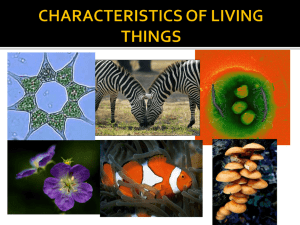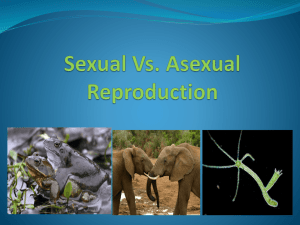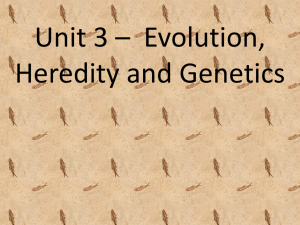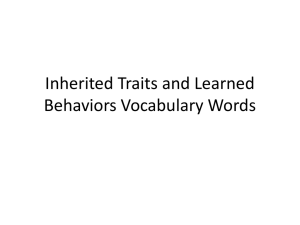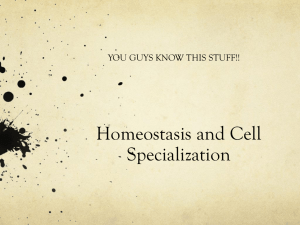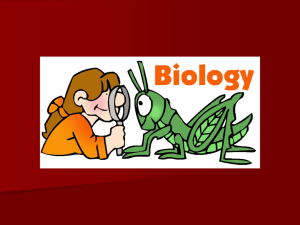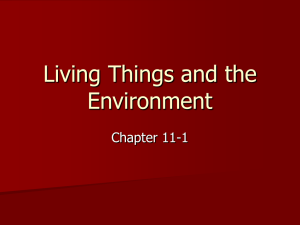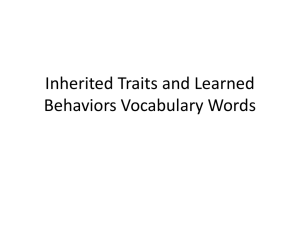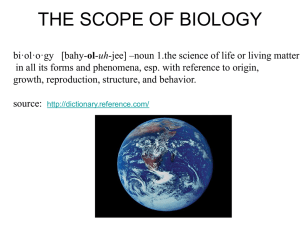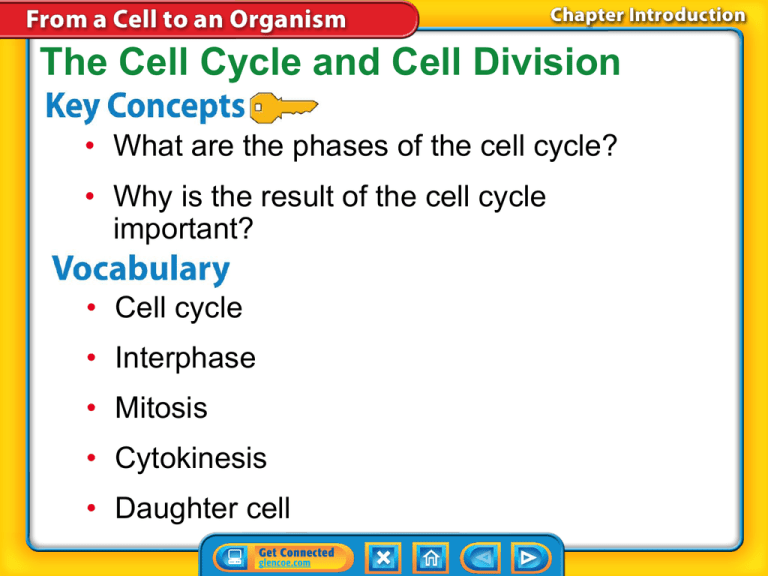
The Cell Cycle and Cell Division
• What are the phases of the cell cycle?
• Why is the result of the cell cycle
important?
• Cell cycle
• Interphase
• Mitosis
• Cytokinesis
• Daughter cell
The Cell Cycle
• Cycles occur in nature.
• The life cycles
of living
organisms such
as trees are
affected by the
change in
seasons.
Bill Brooks/Alamy
The Cell Cycle (cont.)
• Most cells in an organism go through a cycle
of growth, development, and division called
the cell cycle.
• Through the cell cycle,
organisms grow, develop,
replace old or damaged
cells, and produce new
cells.
• There are two main phases in the cell cycle—
interphase and the mitotic phase.
The Results of Cell Division
• The cell cycle results in two new cells,
these new cells are called daughter cells.
• Each daughter cell is genetically identical to
each other and to the original cell that no
longer exists.
Results of Cell Division
The cell cycle is important for
reproduction in some organisms, growth
in multicellular organisms, replacement
of worn out or damaged cells, and repair
of damaged tissues.
• In some unicellular organisms, cell
division is a form of reproduction.
• Cell division allows multicellular
organisms to grow and develop
from one cell.
Levels of Organization
• How do unicellular and multicellular
organisms differ?
• How does cell differentiation lead to
organization within a multicellular organism?
• Cell differentiation
• Tissue
• Organ
• Organ system
Unicellular Organisms
Unicellular organisms carry out all life
processes, including responding to the
environment, getting rid of waste,
growing, and reproducing, within one cell.
• A unicellular organism made of one
prokaryotic cell is called a
prokaryote.
• A unicellular organism made of one
eukaryotic cell is called a eukaryote.
Unicellular Organisms (cont.)
• A cell without a
membrane-bound
nucleus is a
prokaryotic cell.
• A eukaryotic cell has
a membrane-bound
nucleus and many
other specialized
organelles.
Multicellular Organisms
Multicellular organisms are made of
many types of eukaryotic cells working
together, each with a specialized
function.
Multicellular Organisms (cont.)
• All cells in a multicellular organism
come from one cell: a fertilized egg.
• The process by which cells become
different types of cells
is called cell
differentiation.
Multicellular Organisms (cont.)
Tissues are groups of similar types of
cells in multicellular organisms that work
together to carry out specific tasks.
• Humans, like most other animals,
have four main types of tissue:
muscle, connective, nervous, and
epithelial.
Multicellular Organisms (cont.)
• Organs are groups of different tissues
working together to perform a particular
job.
• Organ systems are groups of different
organs that work together to complete
a series of tasks.
Multicellular organisms usually have many
organ systems that work together to carry
out all the jobs needed for the survival of
the organism.
Label each picture below
• A unicellular organism carries out all
the activities necessary for survival
within one cell.
• Cells become specialized in
structure
and function
during cell
differentiation.
• Organs are groups of different
tissues that work together to perform
a job.
What is the process by which cells
become specialized?
A. photosynthesis
B. vascular development
C. prokaryotic process
D. cell differentiation
What is the term for groups of
different organs that work together
to complete a series of tasks?
A. tissues
B. organisms
C. organ systems
D. stem cells
Sexual and Asexual Reproduction
• What is sexual reproduction, and why is it beneficial?
• What is asexual reproduction, and why is it beneficial?
• How do the types of asexual reproduction differ?
•
Sexual reproduction
•
Asexual reproduction
•
Egg
•
Fission
•
Sperm
•
Budding
•
Fertilization
•
Regeneration
•
Zygote
•
Vegetative Reproduction
•
Haploid
•
Cloning
•
Diploid
What is sexual reproduction?
• Sexual reproduction is a type of
reproduction in which the genetic
materials from two different cells
combine, producing an offspring.
• The female sex cell, an egg, forms in
an ovary.
• The male sex cell, a sperm, forms in
the testis.
What is sexual reproduction? (cont.)
During a process
called fertilization,
an egg cell and a
sperm cell join
together to create a
zygote.
Diploid Cells and Haploid Cells
• Organisms that reproduce sexually form
body cells and sex cells.
• In body cells of most organisms, similar
chromosomes occur in pairs.
• Diploid cells are cells that have pairs of
chromosomes.
• Haploid cells are cells that have only one
chromosome from each pair of
chromosomes.
Diploid Cells (cont.)
• Pairs of chromosomes that have
genes for the same traits arranged in
the same order are called
homologous chromosomes.
• Because one chromosome is inherited
from each parent, the chromosomes
are not identical.
• Different organisms have different
numbers of chromosomes.
Advantages of Sexual Reproduction
• Genetic variation occurs in all
organisms that reproduce sexually.
• Due to genetic variation, individuals
within a population have slight
differences.
Advantages of Sexual Reproduction
(cont.)
Genetic variation may enable one plant
to be more disease-resistant than
another within the same species.
Advantages of Sexual Reproduction
(cont.)
Ingram Publishing/
SuperStock
Wally Eberhart/Visuals
Unlimited/Getty Images
Medioimages/PunchStock
image100/SuperStock
Stockbyte/Getty Images
Selective breeding has been used to
develop many types of plants and
animals with desirable traits.
Disadvantages of Sexual
Reproduction
• Organisms have to grow and develop until
they are mature enough to produce sex
cells.
• Organisms must form sex cells—either
eggs or sperm.
What is asexual reproduction?
• In asexual reproduction, one parent
organism produces offspring without
meiosis and fertilization.
• Because the offspring inherit all their
DNA from one parent, they are
genetically identical to each other and
to their parent.
Types of Asexual Reproduction
Cell division in prokaryotes is known as
fission.
• A prokaryote’s DNA molecule is copied
and each copy attaches to the cell
membrane.
• The cell grows longer, pulling the two
copies of DNA apart while the cell
membrane begins to pinch inward
along the middle of the cell.
Types of Asexual Reproduction (cont.)
Through fission, the cell splits and forms
two new identical offspring.
Types of Asexual Reproduction (cont.)
• In mitotic cell division, one organism
forms two genetically identical offspring
through mitosis and cell division. Many
unicellular eukaryotes reproduce in this
way.
• In budding, a new organism grows by
mitosis and cell division on the body of its
parent.
• Budding produces offspring genetically
identical to its parent.
Types of Asexual Reproduction (cont.)
Animal regeneration occurs when an offspring
grows from a piece of its parent.
Types of Asexual Reproduction (cont.)
• Vegetative reproduction is a form of
asexual reproduction in which
offspring grow from a part of a parent
plant.
• Vegetative reproduction usually
involves structures such as the roots,
the stems, and the leaves of plants.
Types of Asexual Reproduction (cont.)
• Cloning is a type of asexual
reproduction performed in a laboratory
that produces identical individuals
from a cell or from a cluster of cells
taken from a multicellular organism.
• Scientists have been able to clone
many animals with the chromosomes
from one parent.
Types of Asexual Reproduction (cont.)
• One disadvantage of asexual
reproduction is that the results offer
little genetic variation within the
population.
• Asexual reproduction can also be
responsible for harmful genetic
mutations.
Types of Asexual Reproduction (cont.)
• One advantage of asexual
reproduction is that it allows
organisms to reproduce without a
mate, saving time and energy.
• Asexual reproduction also enables
some organisms to produce large
numbers of offspring in a short period
of time.
• Fertilization occurs when an egg cell
and a sperm cell join together.
• Sexual reproduction results in
genetic variation among individuals.
Digital Vision Ltd./SuperStock
• In asexual reproduction, offspring are
produced without meiosis and
fertilization.
Steven P. Lynch
• Cloning is one type of asexual
reproduction.
Cells that have pairs of
chromosomes are called ____.
A. chromosomes
B. body cells
C. diploid cells
D. sex cells
Fission refers to the cell division
of which of these?
A. DNA
B. eukaryotes
C. bacteria
D. prokaryotes
Genetics
• Who is the father of genetics?
• How can the environment affect genetics?
•
Heredity
•
Phenotype
•
Genetics
•
Homozygous
•
Dominant trait
•
Heterozygous
•
Recessive trait
•
Punnett square
•
Gene
•
Variation
•
Allele
•
Environment
•
genotype
•
Sex-linked disorders
Early Ideas About Heredity
• Heredity is the passing of traits from
parents to offspring.
• Gregor Mendel is known as the father
of genetics—the study of how traits
are passed from parents to offspring.
Mendel’s Conclusions (cont.)
• A dominant trait is a genetic factor
that blocks another genetic factor.
– dominant traits are expressed using
capital letters
• A recessive trait is a genetic factor
that is blocked by the presence of a
dominant factor.
– recessive traits are expressed using
lower case letters
What Controls Traits (cont.)
• A gene is a section on a chromosome
that has genetic information for one
trait.
• The different forms of a gene are
called alleles. Each chromosome has
one allele for every gene on it.
• The two chromosomes in an offspring
cell may have the same or different
alleles.
What Controls Traits (cont.)
• Geneticists call
how a trait appears,
or is expressed, the
trait’s phenotype.
• The two alleles
that control the
phenotype of a
trait are called the
trait’s genotype.
What Controls Traits (cont.)
• When the two
alleles of a gene
are the same, the
genotype is
homozygous.
• If the two alleles of
a gene are
different, the
genotype is
heterozygous.
Modeling Inheritance
A Punnett square is a model used to
predict possible genotypes and
phenotypes of offspring.
Punnett Square Practice!
• A farmer who raises vegetables wants to cross
two types of corn plants. One type is a
homozygous dominant plant with red kernels
(RR) and the other is a homozygous recessive
plant with white kernels (rr). For these plants,
red color is dominant and white color is
recessive.
• Create a Punnett square on your notes below
to predict the offspring the farmer should
expect.
• Next to the Punnett square answer what color
the offspring will be. Will the plant produce all
red kernels, all white kernels, or a mixture of
both colors?
Genetic Variation Among Siblings
• Because there are two factors (the
sperm and the egg cell) that contribute
to inheritance, the resulting offspring
have genetic variation.
• Variation is a slight difference in an
inherited trait among individual
members of a species.
• Variation can provide resistance to
diseases, and can result in natural
selection among competitive species.
• Genetics is the study of how traits
are passed from parents to offspring.
• The genes for traits are located on
chromosomes.
• Geneticists use
Punnett squares
to predict the
possible
genotypes and
phenotypes of
offspring.
What is the name for different
forms of a gene?
A. alleles
B. phenotypes
C. genotypes
D. chromosomes
What is the genotype when two
alleles of a gene are the same?
A. heterozygous
B. dominant
C. homozygous
D. recessive
Interactions Among Living Things
•
What are ecosystems?
•
What are biotic and abiotic factors?
•
How do individuals and groups of organisms interact?
•
What are some examples of symbiotic relationships?
•
Ecosystems
•
Habitat
•
Abiotic factor
•
Niche
•
Biotic factor
•
Symbiotic Relationship
•
Population
•
Community
What are ecosystems?
• Ecology is the study of how organisms
interact with each other and with their
environments.
• Every organism on Earth lives in an
ecosystem. An ecosystem is all the
living and nonliving things in a given
area.
• Different organisms depend on
different parts of an ecosystem to
survive.
Abiotic Factors
• Abiotic factors are the nonliving
parts of an ecosystem.
• Important abiotic factors include
water, light, temperature, atmosphere,
and soil.
• The types and amounts of abiotic
factors in an ecosystem help to
determine which organisms can live
there.
Biotic Factors
• Biotic factors are all of the living or onceliving things in an ecosystem.
• A population is made up of all the
members of one species that live in an
area.
• Organisms in a population interact and
compete for food, shelter, and mates.
• A community is all the populations that live
together in the same place.
Symbiotic Relationships
• Each population has different ways to
stay alive and reproduce.
• All of the populations in a community
share a habitat, the physical place
where a population or organism lives.
• A niche is the unique ways an
organism survives, obtains food and
shelter, and avoids danger in its
habitat.
Symbiotic Relationships (cont.)
• A symbiotic relationship is one in
which two different species live
together and interact closely over a
long period of time.
• These relationships can be beneficial
to both organisms, beneficial to one
and harmful to the other, or beneficial
to one and neutral to the other.
Types of Symbiotic Relationships
• Mutualism—two species in a
community benefit from the
relationship.
bees and flowers
•
The bee gets food from the flower
•
The flower is able to reproduce
because of the bee
Zebra and Oxpeckers
•
The Zebra gets pest control
•
The Oxpecker gets food
Types of Symbiotic Relationships
• Parasitism—one species (the
parasite) benefits while another (the
host) is harmed.
Dogs and Fleas
•
The Flea gets food (benefits)
•
The Dog is harmed because
the flea feeds on its blood
Mistletoe and Tree
•
The Mistletoe
gets food from
the
tree(benefits)
•
The tree losses
food to the
mistletoe
(harmed)
Types of Symbiotic Relationships
• Commensalism—one species benefits
and the other is neither helped nor
harmed.
Cocklebur and People/Animals
- The Cocklebur benefits from
sticking to a person or animal, so
its seeds can be spread over a long
distance
Cattle egrets and livestock
- The Egrets are able to get insects
when the livestock eats and they
are stirred up out of the field, but
the livestock is unaffected
• Biotic factors are the living parts of an
ecosystem.
• Changes in a community can be very
slow or very rapid.
• The factors that limit the
size a population of
organisms can reach
are called limiting factors.
• A habitat is the physical environment
where a population of organisms lives.
• A symbiotic relationship exists when
two different species of organisms live
together in a close relationship over a
long period of time.
Which of these refers to the
nonliving parts of an ecosystem?
A. abiotic factors
B. biotic factors
C. biomes
D. populations
Which of these refers to all the
populations that live together in
the same place?
A. ecosystem
B. biosphere
C. community
D. biome
In which type of symbiotic
relationship does one organism
benefit while the other is harmed?
A. mutualistic
B. parasitic
C. commensal
D. niche
In which type of symbiotic
relationship does one organism
benefit while the other neither
benefits or is harmed?
A. mutualistic
B. parasitic
C. commensal
D. niche
Energy and Matter
•
How does energy move in ecosystems?
•
How is the movement of energy in an ecosystem modeled?
•
How does matter move in ecosystems?
•
Producer
•
Food web
•
Consumer
•
Energy pyramid
•
Food chain
Energy Flow
• Organisms get energy from food that
they make using light or chemical
energy or by eating other organisms.
• When one organism eats another, the
energy in the organism that is eaten is
transferred to the organism that eats
it.
Energy Flow (cont.)
• Energy travels through organisms,
populations, communities, and
ecosystems in a flow.
• When energy moves
in a flow it does not
return to its source,
as it does in cycles.
Organisms and Energy
• Scientists classify organisms by the
way they get the energy they need to
survive.
• Some organisms, such as plants, are
able to capture the Sun’s energy
directly and convert it into energy-rich
sugars that they use for food.
• Almost all energy on Earth comes
from the Sun.
Organisms and Energy (cont.)
• A few organisms are able to capture energy
from chemicals in the environment and
make food by a process called
chemosynthesis.
• Other organisms cannot capture energy
from sunlight or chemicals and must obtain
their energy by eating food.
• Organisms that cannot make their own food
using the Sun must depend on organisms
that can.
Organisms and Energy (cont.)
Producers change the energy available
in their environment into food energy
that they use to live and reproduce.
Consumers cannot make their own
food and get energy from eating other
organisms
Modeling Energy Flow
A food chain
models how food
energy moves
from the
environment to
several
organisms.
Modeling Energy Flow (cont.)
• Each stage of a food chain has less
available food energy than the last
one, because some food energy is
converted to thermal energy and
moves to the environment.
• A food web is a model that shows
several connected food chains.
Food Web
Modeling Energy Flow (cont.)
• Food chains and food webs are
models used to help understand how
energy travels through a community.
• Terrestrial and aquatic organisms can
interact within a food chain or food
web.
• Food webs show that food energy can
move through several different
pathways.
• A producer changes the energy
available in the environment into
food energy.
• Consumers must use the energy and
nutrients stored in other organisms
for living and reproducing.
• Food webs show that food
energy can move through
several different pathways.
Which type of organism changes
the energy available in its
environment into food energy it
uses to live?
A. producers
C. omnivores
B. consumers
D. herbivores
Which type of model do scientists
use to show several connected
food chains?
A. an energy pyramid
B. a matter cycle
C. a food web
D. an energy flow
Where does the all the energy in
an ecosystem initially come
from?
A. the sun
B. moonlight
C. eating plants
D. minerals in the ground

